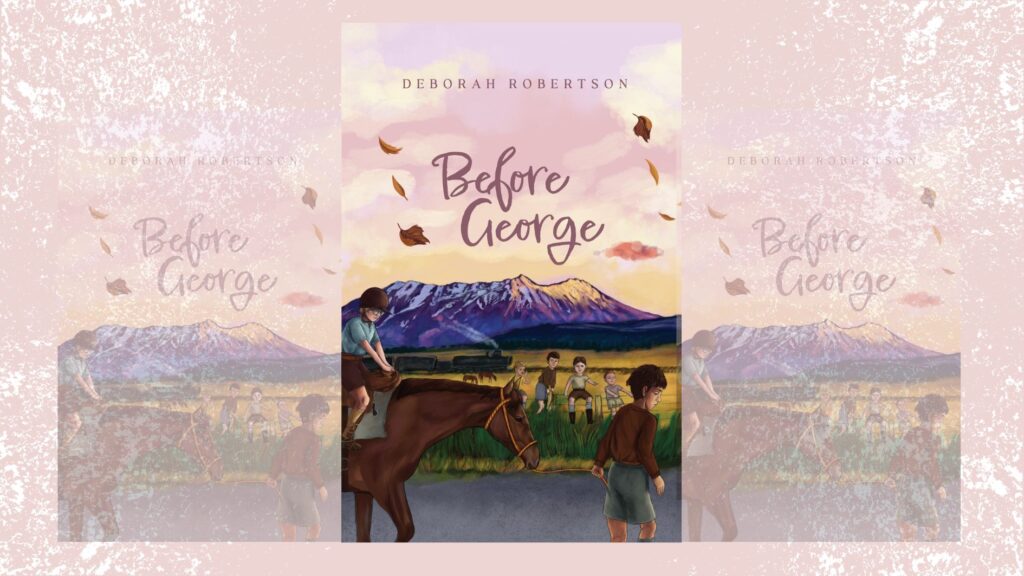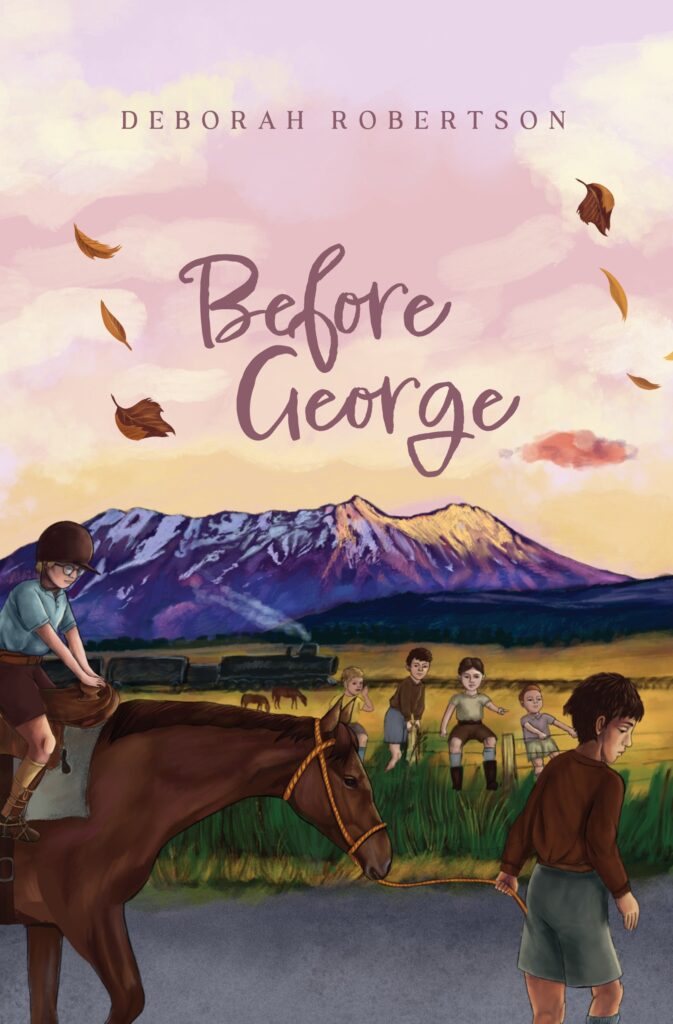High school teacher Briar Lawry deep dives into this compelling journey of a 12-year-old in New Zealand in the 1950s, from her move from South Africa, a rail disaster, and her life and relationships thereafter.

There is something quite telling about the calibre of a book when it effectively opens on one of the most famous New Zealand disasters—and yet that’s far from the most compelling or interesting part of the story.
Which is not to say that the sequence in question, in Deborah Robertson’s Before George, isn’t compelling. It is. It takes you into that moment on Christmas Eve 1953 and brings it to life vividly and horrifically. But as George’s journey progresses after she survives the crash, the challenges of what comes after eclipse that initial trauma.
Hell, the name Tangiwai isn’t even mentioned in the book or the author’s note. I second-guessed myself and Googled the details to make sure that I wasn’t conflating multiple rail disasters.
But I digress.
Before George is the story of a 12-year-old girl far away from what once was home, trying to get by. George’s mother flees her abusive husband with her two daughters in tow, leaving behind life in South Africa for a future in Aotearoa. George is a new name given to her, replacing her original name of Marnya, and her mother ensures that her documentation has George listed as a boy. Because, as she is at pains to remind George, ‘there is nothing more dangerous in the world than being a girl’.
Because, as she is at pains to remind George, ‘there is nothing more dangerous in the world than being a girl’.
Minor spoilers from here onwards. The train that they board after their ship docks is that fateful Wellington–Auckland overnight journey—and both George’s mother and sister are killed. Once it’s established that George doesn’t have any family nearby, just an uncle up north who nobody can find a trace of, she is put in the care of the matron of the boarding hostel attached to the high school in Ohakune. Much to the chagrin of said matron, George insists that she won’t be treated like a girl, that she won’t wear girls’ clothes, that she won’t give any other name but George.
At this point, I want to make it clear that I’m not trying to misgender George. Her relationship with being a girl is complicated, but ultimately, by the end of the book, she holds tight to the name, never willing to go back to being Marnya, but willingly states her girlhood when push comes to shove. She wears maleness as protection, as liberation, but not as an identity shift.
The majority of the book is her life in Ohakune, trying to piece together a life as a third former in a new country. The adults in her life are selfish or enigmatic figures, depending, and the boys she goes to school with are mostly a mixed bag of raucous blokes-in-waiting. But the friendships that she does build are so affirming and strong, and speak to strength of character both in-universe and in crafting by Robertson.
I felt thoroughly immersed in George’s mind and perspective, and I think a big part of that was the fact that it felt so very real.
The character of George—and to a lesser extent, the key supporting characters like Will and Percy—is so well-developed and created. I felt thoroughly immersed in George’s mind and perspective, and I think a big part of that was the fact that it felt so very real. George may be 12, but 12-year-olds dealing with her sorts of challenges have a level of world weariness that is captured in her narration. It doesn’t feel too old, or too young—both of which can easily happen in stories with protagonists this age.
And then there are horses! Enough, I think, that horse book aficionados will be pleased—not so much as to dissuade those who are less equine enthused. My former Pony Pals and Saddle Club-reading self was delighted. The final climax takes place at an A&P show. How much more 50s Aotearoa can you get?
Ultimately, it’s a beautiful book. One I would thoroughly recommend. And if I’m totally honest, much more engaging and deep than I initially thought when I unpacked it and saw the cover.
I want to start this next point by saying that Huia is up there as one of my favourite publishers in the country. I love the stories they put into the world, I love their kaupapa. But I do find that sometimes they have covers that don’t quite align with the story inside. This, and other books targeted at somewhere in the nebulous overlap between older middle grade and younger YA, often look like they are pitched younger than the books themselves are.
I would be suggesting this is an 11 or 12 and up read, even though the cover reads (to me, at least) as something appropriate for a primary-age audience.
I know what a fight it can be to get a fussy and precocious tween or teen to pick up a book that looks too ‘young’ for them. I was one of them, and I have encountered many of them in my years working in children’s books. There is nothing wrong with the cover of Before George, or other books that I face the same challenge with, like Charlie Tangaroa and the Creature from the Sea (heck, I love Phoebe Morris’ work). But I feel that there’s a mismatch between who the book is for and who those covers make them look like they are for—and discussing this with colleagues in kids’ bookshops and school libraries makes me think that I’m not the only one.
Given the heavy nature of some of the themes of the book—the abuse of both George and her mother at her father’s hands, a terrifying attack near the end of the book, her mother’s implied rape and/or possible prostitution—this is not a book for the lower end of middle grade. But it looks like it is. I would be suggesting this is an 11 or 12 and up read, even though the cover reads (to me, at least) as something appropriate for a primary-age audience.
But then again, I read Alex and I Am Not Esther when I was Year 6, so who am I to say how old kids should be when they read particular books?
…if I were still working in kids’ bookshops, it would be high on my hand-sell list this festive season.
As for critiques of the book itself? The ending, while satisfying in some ways, was abrupt. I really wanted to know what happened to Uncle Ryl to cause him to leave South Africa in such a rush. I wanted to see what repercussions there were for Bartholomew and the other Mercher boys for what they did to George—or repercussions for George for her confession in front of Mr Baldwin and everyone else at the A&P show. I wanted to have some sort of final reference to Percy—although I suppose that could have become a bit saccharine.
I’m not sure whether the epilogue was wholly necessary—or whether there could have been a more satisfying way to bring some closure to the Ohakune side of things. What happened to Pilgrim, without George to ride him? Has Mrs Taylor taken in another orphan to fleece them of their allowance? What was the immediate reaction when George ran away?
But you know what? These are all things that occurred to me on reflection, in the writing of this review. When I finished the book, sitting in my school library during a non-contact, I had a smile on my face, and raced over to my wonderful head librarian friend to rant about how much I loved it and how she needed to make sure she had it coming in.
I’m still not quite sure what the title is about—surely it’s as much ‘during’ and ‘after’ George as it is ‘before’—but I loved this book nonetheless, and if I were still working in kids’ bookshops, it would be high on my hand-sell list this festive season.


Briar Lawry is an English teacher and writer from Tāmaki Makaurau. She worked in bookshops for years, most notably Little Unity, and judged the NZCYA Awards in 2020. She was also one of the editors of The Sapling between 2019 and 2023.



